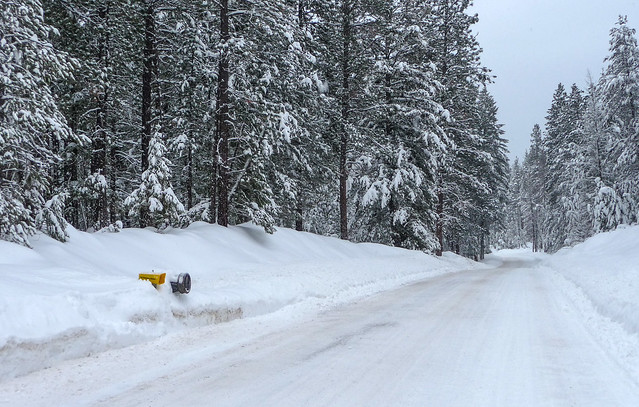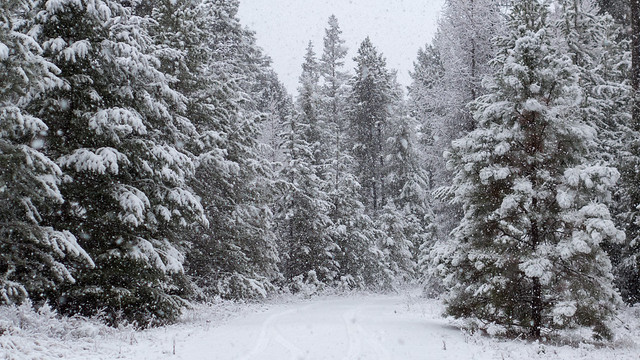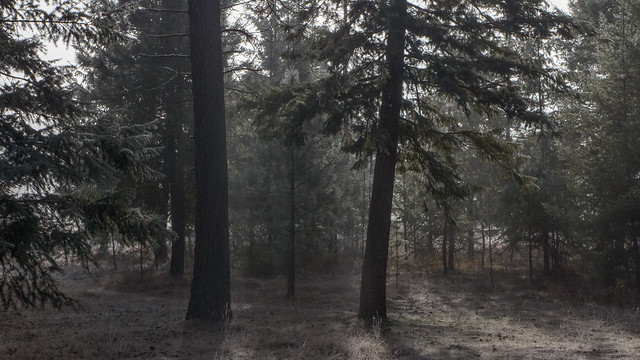
Autumn came late this year, and climate change was very much on my mind as the skies remained warm and dry throughout much of October. With our house windows left open long after dark to cool the place down, I lingered over the pictures and stories of deep snows in the book I’ve just finished editing and publishing for my fellow Eastern Washington resident Gerald Hickman. Good Times in Old Genesee: A Tale of Two Families (Tellectual Press, 2015) is about a tiny dot of a pioneer town a couple hours’ drive south of here where Gerald and his parents were born and raised.
When he was growing up, it snowed there. A lot, if the “walked through miles of snow to school, uphill both ways” memories of an elder citizen can be relied upon:
My brother and sister and I would walk down the steep hill on our ranch road about a half mile through the snow drifts to catch a ride to school on the bus. We had to buck the drifts about ten months of each year. Finally, when summer came, we were mostly snow-free, and free of classes as well.3
He recalls snowball fights and sled riding down a hill on the drive to his childhood home. “The best part: We were really close to home for hot chocolate from Mom’s warm and loving kitchen.” 4
In the early 1900s, he says (here drawing on historical research rather than memory), “there was often so much snow that they had to tunnel under the snow to cross Main Street.”
His great-uncle John Platt, who arrived in Genesee as a child with his family in the late 1800s, “said that the snow did not seem so deep around Genesee in the later years of his life,” and Gerald agrees. “With the exceptional year or two, winters seem to have become less severe in my later years as well.” 5
Just in the 15 years or so we’ve been in the Inland Northwest, we’ve seen a decrease in snowfall. I love the feeling of huddling inside our house with the woodstove burning wood I grew, logged, hauled, bucked, split, and stacked myself, from my own property, as the snow fills the skies and piles up outside. I love stomping through it and seeing the cold clean whiteness of it all, the graceful curves of it piled on trees and roofs, softening every sharp angle. One memorable winter, I spent 26 days skiing down it on a mountain that is less than 40 minutes from my driveway.
Now, thanks in part to automobile trips as long as the ones I made back and forth to that ski hill, undertaken every day by millions of commuters across the country and beyond, those snowfalls are faltering. Climate change, driven by greenhouse gas emissions from my tailpipe and everyone else’s, has thinned the clouds in our Pacific Northwest skies. When they do offer us the winter moisture that has carpeted this region with evergreens, it often comes down as rain rather than snow.
According to a Nepalese study cited in Bill McKibben’s book Eaarth: Making a Life on a Tough New Planet, there has been an annual temperature rise of 0.1°F in the Himalayas. That, McKibben observes, works out to “a degree every decade in a world where the mercury barely budged for ten millennia.”
In 2008, a 57-year old Nepalese man looking at a glacier that’s retreated more than a mile since he played on it as a child said, “I feel that the sun is getting stronger, and in the past there used to be a lot more snow in winter. We used to get up to two metres in the winter, and it would stay for weeks. Last winter we only had two centimetres.” 6
The drastic warmth in Nepal “is spurring melt with almost unimaginable consequences,” says McKibben.
Indian researchers recently predicted that glaciers could disappear from the central and eastern Himalayas as early as 2035, including the giant Gangotri Glacier that supplies 70 percent of the dry-season water to the Ganges River. That would leave 407 million people looking for a new source of drinking and irrigation water.7
On the other side of India lies Pakistan, “a country that is essentially a desert with a big river flowing through it.” 8 That river is the Indus, which is fed by glaciers in “the Himalayas, the Hindu Kush and the Karakoram, forming the largest reservoir of ice outside the poles.” This is a country that is already getting hit by climate change, with “catastrophic floods which displaced millions, and a deadly heatwave this summer that killed 1,200 people.” 9
But the suffering is only going to get worse, because those glaciers are retreating fast. By 2050, the Intergovernmental Panel on Climate Change “predicts a decrease in the freshwater supply of South Asia, particularly in large river basins such as the Indus.” Karachi, which draws almost all of its water from the Indus “will somehow have to manage its growing population with even less water–a population with a significant poverty rate that will also struggle should food prices rise.” 10
This is not just a problem for some distant people we never see except occasionally on the news, because India and Pakistan both have nuclear weapons, about a hundred between them as of 2010. They glare at each other across a hostile border, possibly “the most worrisome adversaries capable of a regional nuclear conflict today.” 11 What happens when one of them–thoroughly infected with religious fanaticism and filled with millions of desperate, starving citizens–finally decides to lash out at its hated rival?
Consider, as Gwynne Dyer does in his scary look forward to a planet at war over climate pressures, that five
of the six rivers that eventually feed into the Indus system rise in Indian-controlled territory. In undivided, British-ruled India, the water flowed unhindered into the intricately linked irrigation canals that covered much of the provinces of Punjab and Sind, but Partition in 1947 left most of the headwaters in Indian hands, while well over four-fifths of the farmers who depended on the water lived in the new state of Pakistan.12
Nations do not “go gentle into that good night” when dwindling resources make bare survival look impossible. Backed against the wall, with military options at hand–frightfully so in Pakistan and India to say nothing of China, another thirsty nation with dicey water prospects–they follow Dylan Thomas’s poetic admonition to “rage, rage, against the dying of the light.” 13 The consequences are horrific for their neighbors, sometimes the entire world.
This is what Lebensraum was all about, as historian Tim Snyder soberly explained on a recent episode of Tom Ashbrook’s On Point NPR program. Climate change could well return us to a tribalistic world convulsed by resource wars. We are already seeing the beginning of sorrows in the mass exodus from Syria.
“Organized societies can endure a lot of hardship and still carry on, but when populations go hungry all bets are off for cultural cohesion and political stability,” observes James Howard Kunstler in his masterpiece Too Much Magic.
If world events follow their usual perverse course, food shortages and other resource scarcities will express themselves indirectly in quarrels that may seem to have little to do with the pertinent issues: conflicts over abstractions such as interest rates and currencies, trade wars, revolutions, fights over boundaries and islands, nationalist chest-beating displays, and religious warfare of the jihad and crusade variety. There may be little public acknowledgment or even consciousness of the reasons behind one outburst of trouble or another.14
And we certainly can’t expect that an abused planet already under stress would respond well to even a “local” outbreak of mushroom clouds in the Subcontinent:
A nuclear war could trigger declines in yield nearly everywhere at once, and a worldwide panic could bring the global agricultural trading system to a halt, with severe shortages in many places. Around one billion people worldwide who now live on marginal food supplies would be directly threatened with starvation by a nuclear war between India and Pakistan or between other regional nuclear powers.15
It’s a grim picture, and there has been no shortage of what doomsday ecologist Guy McPherson memorably calls “hopium” to assuage a public that’s becoming increasingly concerned, despite campaigns of denial financed by fossil fuel interests. The pharmacopoeia of hopium includes grandiose techno-fixes such as implausible carbon capture schemes and seeding the stratosphere with sulfates to reflect solar radiation. Bill McKibben is critical of such fantasies, though with some sympathy for “the daydreams of the developing world” like the suggestion made at a meeting of Asian journalists that “Bangladesh could be relocated to Siberia and Iceland.” Melting snows would, it was claimed, “turn them into ‘bread-baskets.’” How, he asks, does one tell these front-line casualties of our war against nature “that the tundra is turning into a methane-leaking swamp?” 16
Besides, there is the small issue of what the Russians and Icelanders might think about an invasion of 150 million Bangladeshis. Even an enlightened new generation of Germans ever mindful of their grandparents’ Holocaust is getting twitchy about all the Syrian refugees mobbing their borders.

“Have you entered the storehouses of the snow, or have you seen the storehouses of the hail,” the Book of Job has God sniff at us mere mortals, storm-stuff that he has “reserved for the time of distress, for the day of war and battle?” 17 Those storehouses are not hidden somewhere above clouds in God’s heaven, but on snow-capped mountains right here on earth. Their stock is running low, not just in the Himalayas, but around the world in this time of distress we have made for ourselves.
The last of Bolivia’s 18,000 year-old Chacaltaya Glacier melted away in 2009.18 Andean glaciers like that one are “the main source of water across South America, from Colombia to Ecuador, Peru, Bolivia and Chile,” and their disappearance is going to cause major problems. One climate change advisor for Latin America at a humanitarian organization says that conflicts over water “will become explosive over the coming decades because the glaciers will dry out.” 19

Agriculture “is practically at an end in California’s Central Valley,” says Dyer, “due to the failure of the rivers that used to be fed in the summer by the melting snowpack on the Sierra Nevada and Rocky Mountains.” 20 This is not a trivial situation: The Central Valley “accounts for one-quarter of the food grown for human consumption in the United States.” But its rivers will likely become seasonal in world that is 2°C warmer, flowing only in the winter with precipitation that falls on the mountains mostly as rain instead of snow.21
The Sierra Nevada mountain range is, or was, “a giant water faucet in the sky, a 400-mile-long, 60-mile-wide reservoir held in cold storage that supplies California with more than 60 percent of its water.” Now the snow is coming later and melting earlier.22
Rainwater, alas, runs off immediately instead of adding to a storehouse of moisture that melts and feeds rivers late into the spring and summer.23 Farmers and ranchers in the American West need that slowly melting snow to keep water flowing throughout the dry summer. Otherwise, a lot of the water is gone by the time their crops need it.24
And there are a lot of us eating food produced from those crops. Don’t kid yourself about agricultural abundance from the Midwest, either. About 30% of the groundwater used for irrigation in the U.S. comes from the Ogallala Aquifer, the saturated volume of which has gone down by about 9% since 1950, according to Wikipedia. “Depletion is accelerating, with 2% lost between 2001 and 2009 alone. Once depleted, the aquifer will take over 6,000 years to replenish naturally through rainfall.” 25 In the crucial Kansas section of the Ogallala, 30% has already been pumped out and farming there will likely peak by around 2040 due to water depletion.26

Meanwhile, back in Latah County where Gerald Hickman’s little town of Genesee still sits among the monoculture, petroleum-fertilized grain fields of Big Ag, a local club in the Idaho State Snowmobile Association (“Snodrifters of Latah County”) canceled its February 15, 2015 “Raffle Run” due to lack of snow. “Look for us to be back next year,” they plead on their website.27
For reasons that go far beyond a little winter recreation, we can only hope they will be.
Notes
-
Quoted in “Retreat of Once-Mighty Glacier Signals Water Crisis, Mirroring Worldwide Trend” by Doug Struck (Washington Post, July 29, 2006), dougstruck.com/journalism/on-the-roof-of-peru-omens-in-the-ice. ↩
-
Dated according to Julie R. Monroe in her book Latah County (p. 41). ↩
-
Gerald Hickman and Tea Joe Hickman, Good Times in Old Genesee: A Tale of Two Families (Tellectual Press, 2015), loc. 333. ↩
-
Hickman at loc. 511. ↩
-
Hickman at loc. 522. ↩
-
“Himalayan villagers on global warming frontline,” phayul.com/news/article.aspx?id=23518. ↩
-
Bill McKibben, Eaarth: Making a Life on a Tough New Planet (Henry Holt and Co., 2010), p. 7. ↩
-
Gwynne Dyer, Climate Wars: The Fight for Survival as the World Overheats (Oneworld Publications, 2010), loc. 1758. ↩
-
“Climate Change Bomb Ticking in Pakistan”, Khaleej Times (Oct. 21, 2015). ↩
-
Khaleej Times. ↩
-
Alan Robock and Owen Brian Toon, “Local Nuclear War, Global Suffering,” Scientific American (Jan. 2010), pp. 74-81. ↩
-
Dyer at loc. 1761. ↩
-
James Howard Kunstler, Too Much Magic: Wishful Thinking, Technology, and the Fate of the Nation (Grove/Atlantic, 2012), loc. 3477. ↩
-
Robock and Toon. Ironically, one result of a nuclear war (even a regional one) would be a drastic cooling of the planet into a “nuclear winter” situation. Some consolation! ↩
-
McKibben at p. 100. ↩
-
Job 32:22-23, New American Standard Bible. ↩
-
McKibben at p. 7. ↩
-
Eva Mahnke, “Water conflicts come to the Andes as glaciers melt” (Deutsche Welle, Nov. 13, 2012), dw.com/p/16iC6. ↩
-
Gwynne Dyer, Climate Wars: The Fight for Survival as the World Overheats (Oneworld Publications, 2010), loc. 387. ↩
-
Dyer at loc. 997. ↩
-
Tom Knudson, “Sierra Warming: Later snow, earlier melt: High anxiety” (The Sacramento Bee, Dec. 28, 2008, online version here). ↩
-
Dyer at loc. 997. ↩
-
McKibben at p. 44. ↩
-
Brad Plumer, “How long before the Great Plains runs out of water?” (Washington Post Wonkblog, Sept. 12, 2013). ↩


